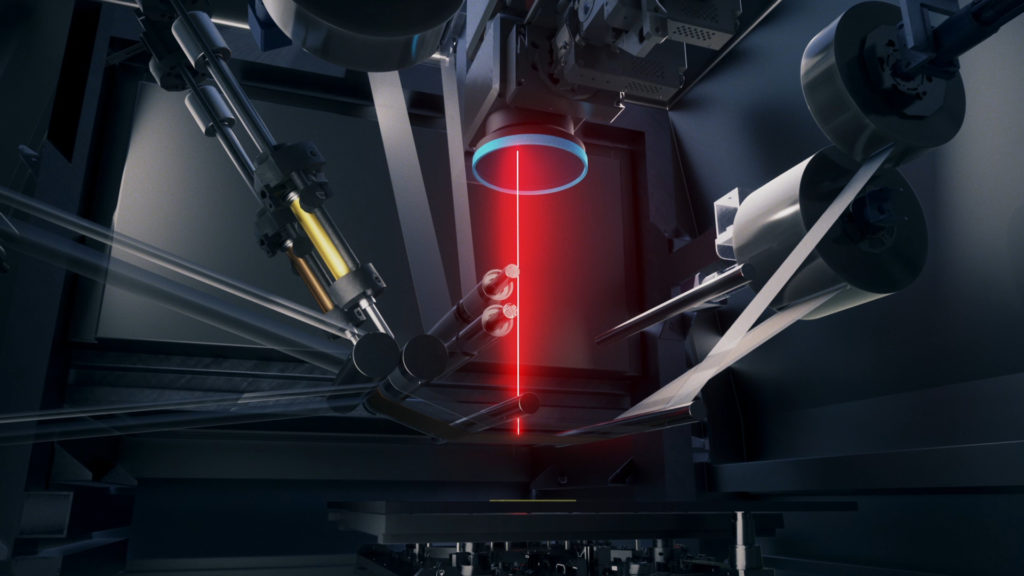3D Printing News Briefs, July 17, 2021: SME, Z3DLAB & CNRS, GKN Additive, FibreTuff & RSNA, Nano Dimension & Hensoldt, ioTech
In today’s 3D Printing News Briefs, we’ll tell you about a rebranded case study award, and then a few stories about 3D printing materials. Finishing up, we’re sharing news about a new joint venture, and then a newly launched AM technology. Read on for the stories!
Rebranded Aubin AM Case Study Award
SME announced its updated and rebranded Aubin AM Case Study Award, with a submission deadline of August 1st, 2021. The award is looking to recognize innovation in AM applications and use cases of adoption and implementation, as well as offering inspiration to others on their own AM journey. Applicants must submit a graphical abstract (which may be used for marketing) and a technical brief, containing less than three pages of text explaining the details of the case study or innovation to not only the judges but also community members looking for more information.
“The finalists will be selected from the submissions (graphical abstracts and technical briefs) to present their work at RAPID as Invited Technical Presentations (may be virtual in 2021),” SME wrote.
“The presentations will allow the applicant to present the content of their technical brief to conference attendees in a special session of the RAPID+TCT conference. A panel of judges will be present and evaluate the presentations to determine the winner of the award. The technical presentations should have the same breakdown of content as the technical brief and should span no more than 15 minutes.”
CoCoA-Bio Alloys for 3D Printed Implants
3D printing titanium specialist Z3DLAB has joined a consortium of Centre national de la recherche scientifique (CNRS), which recently received funding from the French National Research Agency (ANR) in order to create new complex concentrated alloys for 3D printing bio-implants, or CoCoA-Bio. As the population continues to age, the risk of bone accidents and diseases is also going up, and we’re in need of materials with good mechanical properties and excellent biocompatibility to help. CoCoA-Bio essentially combines two metallurgical concepts to offer a potential solution to this issue, and will use SLM 3D printing to fabricate multicomponent and complex concentrated alloys (HEA/CCAs) based on TiNbZr-X (X = Mo, Ta). Dental implant model prototypes will be used to validate the work.
“The consortium is confident that the CoCoA-Bio project will participate in requalifying the HEAs from promising materials to truly candidates to replace the material solutions currently applied (for lack of anything better), in our case alloys for bio-implants. The cross expertise and resources of the consortium on additive manufacturing, the design and characterization of HEAs and their surface functionalization are important assets for achieving the objectives of the CoCoA-Bio proposal.”
GKN Additive’s 3D Print Process for Low-Alloy Steels

The cross-section of the FSLA material shows the dual-phase microstructure after heat treatment (dark: martensite / bainite; light: ferrite). By the heat treatment, the proportion of the different phases and the grain size can be adjusted to achieve unique physical properties.”
GKN Additive, a digital manufacturer of advanced 3D printed parts and materials, has come up with a 3D printing process for low alloy dual-phase steel materials, often used in automotive and industrial applications. In what the company is referring to as an “industry-first,” it’s adapted and enhanced a DP600-like material into two new metal powder materials, DPLA (Dual Phase Low Alloy) for laser powder bed fusion and FSLA (Free Sintering Low Alloy) for binder jetting. These materials, now available for purchase, are unique in their specialization for AM, such as laser absorption, spreadability, and sinterability.
“Traditional DP600 offers specific standardized mechanical properties achieved by heat treatment,” explained Christopher Schaak, Technology Manager for Binder Jetting at GKN Additive.
“The dual-phase steel AM materials developed by GKN Additive on the other hand are very flexible in their characteristics, as their mechanical properties can be tuned more widely by the heat treatment after the laser or binder jetting process.
“With these AM processes, manufacturers in the Automotive industry can construct body parts differently than what was possible with traditional sheet metal parts. If you look at a tailored blank, many sheet- metal parts and support parts need to be formed and joined together to achieve a certain stiffness. By using structural components printed with AM on the other hand, you would need less process steps and less material, leading to cost optimization and a weight reduction.”
FibreTuff Filament Used for Bone-Like Models
Robert Joyce, the Founder of Ohio-based FibreTuff, reached out with some new developments on the company’s bone-like filaments. It seems that Dr. Mike Hartman, a craniomaxillofacial surgeon at Hartman Oral and Maxillofacial Surgery, P.C. in Pennsylvania, has been using FibreTuff filaments to print anatomical bone-like models, such as the scapula seen above, for CT scans, and indicated that the material meets the requirements and guidelines for medical 3D printing and appropriate clinical scenarios laid out by the Radiological Society of North America (RSNA) 3D Printing Special Interest Group (SIG).
“Not only does the FibreTuff have radiopacity with a micropore structure but can be coated with a eco friendly solution to have a bone ring, similar to real bone in the CT Scan,” Joyce said.
FibreTuff will be attending the RSNA’s annual meeting in Chicago later this year, November 28-December 2nd.
Joint Venture: Nano Dimension & Hensoldt AG
3D printed electronics provider Nano Dimension and and Hensoldt AG, a market leader in civilian and military sensor solutions and defense and security electronics, have partnered up to form a joint venture entity, J.A.M.E.S GmbH, which stands for Jetted Additively Manufactures Electronics Sources. The vision of J.A.M.E.S is to advance, prototype, and share 3D electronics printing designs, and ultimately lead a revolution in electronic fabrication and manufacturing. Hensoldt has been using Nano Dimension’s DragonFly PRO and LDM 3D-AME printer for several years to make products like printed circuit boards (PCBs), and the two are working together, and co-investing roughly $6 million into their Germany-based joint venture entity, to expand the capabilities of AME 3D Hi-PEDs, or Additively Manufactured Electronics High-Performance-Electronic-Devices.
“HENSOLDT, as a market leader in the field of sensor technology and optronics, expects the closer cooperation with Nano Dimension to accelerate development cycles as well as spare parts production to respond to customer needs more quickly and cost-effectively. Using special dielectric and conductive nanoparticle inks, it is now possible to design electrical components directly via the printer and bring them into a three-dimensional form,” said Marian Rachow, Head of HENSOLDT Ventures, who will serve on the J.A.M.E.S Board of Directors.
“HENSOLDT has been investing in basic research of digital 3D printing of electronic components for several years to make the benefits of this technology available for its own development and production. For example, in collaboration with Nano Dimension, HENSOLDT has already printed the world’s first 10-layer PCB, which carries soldered high-performance electronic structures on both outer sides, using a newly developed polymer ink from Nano Dimension. Increasing competition and accelerated customer procurement timelines will be one of the biggest challenges for established providers in the future. Our joint venture, J.A.M.E.S, not only offers rapid development of technology as a real alternative to conventional electronics manufacturing, but also offers small and medium-sized companies the opportunity to efficiently design new products.”
ioTech Group Launches C.L.A.D. Technology
London-based startup ioTech Group Ltd is also looking to shake things up in the additively manufactured electronics industry, and is launching what it says is the first Continuous Laser Assisted Deposition (C.L.A.D.) technology, dedicated to electronics manufacturing. According to the company, this multilateral AM technology can process nearly any industry-certified material at high speed and high resolution, making it possible to offer full commercial solutions across multiple industries and achieve flexibility for electronics and additive mass manufacturing. ASM Pacific Technologies (ASMPT), which supplies hardware and software solutions for manufacturing electronics and semiconductors, was an early investor of ioTech’s C.L.A.D. technology, and Henkel Adhesive Technologies, a global leader in the adhesives market, is now making an investment of its own.
“We are excited to introduce our unique C.L.A.D. technology to the electronics industry and additive manufacturing. Its ability to deposit any flowable industrial material for so many applications is unprecedented. It will increase production efficiencies and encourage innovation for many companies. A whole host of industries will be able to adopt an agile manufacturing approach to deliver fully functional products fast, facilitating mass customization when required, and at the same time, be eco-friendly,” said Dr. Michael Zenou, ioTech’s Co-Founder and CTO. “The flexibility of C.L.A.D. is simply remarkable.”
Subscribe to Our Email Newsletter
Stay up-to-date on all the latest news from the 3D printing industry and receive information and offers from third party vendors.
You May Also Like
Gorilla Sports GE’s First 3D Printed Titanium Cast
How do you help a gorilla with a broken arm? Sounds like the start of a bad joke a zookeeper might tell, but it’s an actual dilemma recently faced by...
Nylon 3D Printed Parts Made More Functional with Coatings & Colors
Parts 3D printed from polyamide (PA, Nylon) 12 using powder bed fusion (PBF) are a mainstay in the additive manufacturing (AM) industry. While post-finishing processes have improved the porosity of...
$25M to Back Sintavia’s Largest Expansion of Metal 3D Printing Capacity Since 2019
Sintavia, the digital manufacturing company specializing in mission-critical parts for strategic sectors, announced a $25 million investment to increase its production capacity, the largest expansion to its operations since 2019....
Velo3D Initiates Public Offering in a Bid to Strengthen Financial Foundations and Drive Future Growth
Velo3D (NYSE: VLD) has been among a number of publicly traded 3D printing firms that have attempted to weather the current macroeconomic climate. After posting a challenging financial report for 2023,...




































